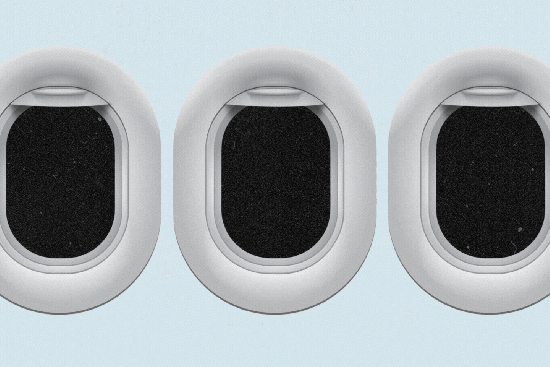
Why these passengers are flying up to 30 hours to see four minutes of the eclipse
Millions of eager stargazers are gearing up for the total solar eclipse that will be visible from Texas to Maine on April 8. But while most people are making plans to be on the ground for the spectacle, a smaller group of enthusiasts are hoping to find an even better view—from 30,000 feet in the air.
“Typically you’re on the ground looking up and hoping there won’t be any clouds,” says Do Trinh, an IT risk consultant in Amsterdam. “Wouldn’t it be cool to experience the eclipse from the sky?”
[time-brightcove not-tgx=”true”]Trinh is part of a growing cohort of eclipse buffs who are opting to board commercial flights along the eclipse’s path, just to catch a brief glimpse of the moon obscuring the sun. His fascination with the idea was sparked by a captivating photo of the 2017 eclipse taken from an airplane, motivating him to want to witness the phenomenon from the same vantage point.
After scanning airline schedules and checking the angle of the sun, Trinh in early January decided to book a flight from Amsterdam to the U.S. and drop another $500 on a Delta Air Lines flight from San Antonio to Detroit, securing a window seat on the left side of the plane four months in advance. “I’ll be flying 30 hours for four and a half minutes of totality,” Trinh says with a chuckle, “so it’s a big investment.”
Read More: The ‘Devil Comet’ Will Be a Heavenly Co-Star During the Eclipse. Here’s What to Know
But a couple weeks after he booked it, the flight was pushed back by about three hours, falling outside the time of the eclipse. He managed to rebook himself into a first-class window seat on a new flight from Austin to Detroit, which Delta said is being operated specially for umbraphiles like Trinh. Trinh booked a second eclipse flight on Southwest Airlines just in case.
Several airlines are offering flights expected to have a high-level view of the eclipse, but Delta is specifically marketing its flights to those who want to spend as much time as possible within the path of totality. Delta will be flying two routes—the first on an Airbus A220 with extra-long windows, even in the bathroom, and the second on an A321neo. Seats for both flights, costing over $1,000, quickly sold out, and searches for the eclipse flight path on Delta channels spiked by more than 1,500% after it was announced, according to a Delta spokesperson.
Jamie Larounis, a travel industry analyst in Washington, D.C., was hoping to be on Delta’s first eclipse flight from Austin to Detroit, but by the time he heard about it, the flight was already fully booked. A couple weeks later, however, he got an email from Delta saying that a second eclipse flight was added from Dallas to Detroit. He didn’t waste any time. “I was one of the first to book,” he says. “I didn’t bat an eye.”
Read More: Here’s What Determines How Long the Total Eclipse Will Last in Your Location
The tickets were listed for well over $1,000, but some travelers like Larounis managed to use Delta’s rewards program to help lower the cost. Larounis says it cost him 100,000 SkyMiles, worth around $1,150, for a window seat on the left side of the plane in first class. “From what I had read, this would be a once in a lifetime opportunity, so I wanted to take advantage,” he says.
A Delta spokesperson says the airline plans to make “a series of turns in the area of totality to allow for views from both sides of the aircraft during these flights,” as long as the Federal Aviation Administration (FAA) and air traffic control give approval on the day of the flight. Delta will also provide all passengers with ISO-certified viewing glasses, which are required for eclipse watchers.
But the FAA has warned that air traffic delays are likely on April 8 due to crowded airspace, posing potential challenges for eclipse-bound flights and their meticulously planned viewing schedules. The stakes are high for eclipse enthusiasts. Any disruptions to flights could result in missing the crucial moment of totality—when the moon obscures the sun for roughly three to five minutes.
When Larounis booked his flight, he wasn’t that concerned about these possible issues. But as the adrenaline of booking one of the first seats began to wear off, he started to wonder if the flight would encounter any last-minute obstacles. “Now, after the fact, I’m concerned things won’t go off as planned,” he says, “though I have to hope that because Delta marketed this as a specific eclipse flight, they’d either make good in getting the flight to go, or providing some sort of refund if they think it won’t go as planned.”
Read More: How to Use Your Smartphone to Take Photos of the Solar Eclipse
A Delta spokesperson says the airline has contingency plans in place in the event that outside factors impact the eclipse flights. “We will do everything within our control to make these flights an amazing experience for our customers,” the spokesperson says. “This can include alternative routing and altitudes that our teams coordinate with Delta operations teams on the ground and air traffic control.”
Passengers have to hope that everything goes right for them to view the roughly four minutes of totality on their flight. If not, they’ll have to wait more than 20 years for another total solar eclipse to pass across the U.S. “I’ve never seen an eclipse before from either the ground or air, so I don’t know how the experience will compare,” Larounis says, “but if I can do it from the air, I should.”